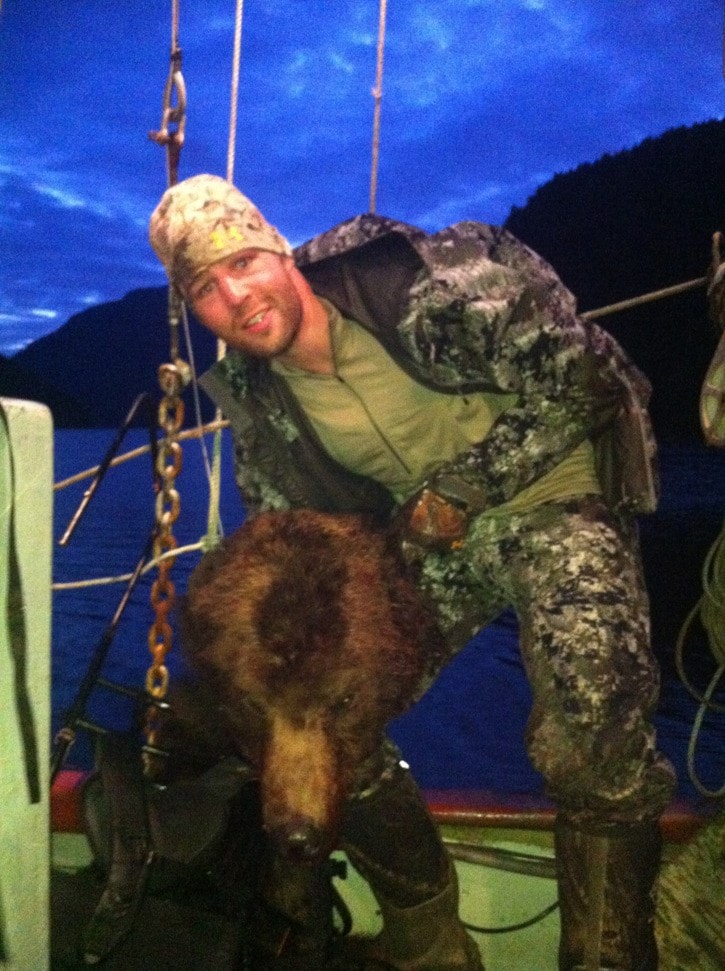A documentary film released last week by the Coastal First Nations is once again stirring up controversy around B.C.’s grizzly hunt. The film profiles the land, people, and bears on the Central Coast and focuses most specifically on the killing of a young male grizzly in the Kwatna estuary that Coastal First Nations field technicians had nicknamed ‘Cheeky.’
The Coastal First Nations, a nine-member group that includes local nations such as the Nuxalk, Heiltsuk, Wuikinuxv, and Kitasoo-Xaixais, declared a ban on trophy hunting in their traditional territories last fall. The group erected signs and continues to patrol the area during hunting season, asking bear hunters to leave.
The B.C. government, however, doesn’t recognize the ban, and continues to issue grizzly bear hunting permits for the area. ‘Cheeky’ was killed under one of these permits last spring.
While the B.C. government claims that the hunt is based on ‘sound science,’ the film questions this claim and makes the case that the trophy hunting of grizzly bears is unethical, barbaric, and in complete opposition to the traditional laws governing the First Nations territories where these bears reside.
“We would ask that the Coastal First Nations respect the province’s authority over the harvest,” said Steve Thomson, B.C.’s Minister of Forests and Lands. “It’s a harvest that is based on best available science. We believe we have a good management regime in place and we would ask that they respect that.”
According to a 2012 estimate, the B.C. government says there are about 15,000 grizzly bears in the province. Under the current management plan, about 300 grizzlies are shot by resident and non-resident hunters in B.C. each year. In 2012, non-residents killed 1,141 black bears and 69 grizzlies in B.C., while residents killed 2,767 black bears and 181 grizzlies.
Grizzly bear hunting is a costly sport – especially for non-residents, who can expect to pay up to $16,000 for a guided hunt. The Guide Outfitters Association of British Columbia estimates its members employ more than 2,000 people and generate about $116-million worth of economic activity each year.
The Coastal First Nations says bears are worth much more alive, as eco-tourism continues to thrive in B.C. and bear watching is a huge draw. “We basically want to send the message that bears are worth more alive than they are dead,” said Doug Neasloss, chief councillor with the Kitasoo Band Council. “We fully intend on implementing our ban again this year.”
Dr. Chris Darimont, a conservation scientist with the University of Victoria who works closely with the communities of the Central Coast on their bear monitoring projects, is says the province has ‘little to no idea’ how many bears live in B.C.
“The idea that this hunt is based on sound science is absurd. Very notably, the models from the coast don’t include salmon as a parameter. That’s absurd, that sort of omission,” said Darimont, who’s in the process of publishing a peer-reviewed paper on bear populations after a season of field work on the central B.C. coast. “We know that grizzlies in particular are closely coupled to how much salmon there are in ecosystems. We know with clear certainty that there’s far less salmon now. So we can infer really confidently that there are far less bears.”
Darimont also takes issue with using science to determine ethics “Science provides information, it does not provide the permission to behave unethically,” he said. “It is unethical behaviour to kill something without eating it.”
Megan Moody, a researcher with the Nuxalk Nation, agrees. “The truth is we that we really don’t know how many bears are there,” she says. “I would rather protect them than pretend we know what’s going on and allow the needless killing of them.”
A trophy hunt of any kind is controversial to many, but the grizzly seems to hold special significance in this debate as virtually no one eats grizzly bear meat, making the entire process of killing the animal one of ‘sport.’
“This hunt is inhumane and barbaric,” said William Housty of the Heiltsuk Nation. “I don’t think it’s just a First Nations issue to have respect for these animals; it’s bigger than that, it’s wider than that.”
Recent polls suggest the vast majority of B.C. residents agree. Last week, Coastal First Nations released an opinion poll conducted by McAllister Opinion Research which found that 87 per cent of British Columbians agree the grizzly hunt “should be banned,” including 78 per cent of respondents who “strongly” support such a closure.
The film has also attracted some unwanted attention for Clayton Stoner, a B.C.-born NHL player who currently plays for the Minnesota Wild. While the film does not name Stoner or show his face, a photo was leaked showing Stoner holding the severed head and paws of ‘Cheeky’ the day before the film’s release.
“Those photos were taken by one of my field technicians this spring,” confirmed Jessie Housty of the Heiltsuk First Nation. “In this particular case, our technician was invited onto the hunter’s boat and had a conversation with him. The man in the photo identified himself to our field technicians as being Clayton Stoner.”
Stoner issued a statement saying he obtained the grizzly bear permit fairly through the government lottery system. “I love to hunt and fish and will continue to do so with my family and friends in British Columbia,” he said.
Housty said the film is not intended to vilify individual hunters and the Coastal First Nations did not leak the pictures. She remains concerned that the pictures will draw attention away from the main message of the film.
“This is a bigger issue for us than one hunter. It’s about the hunting culture. It’s not about finding a villain, it’s about stimulating dialogue and changing the narrative we see,” said Housty. ““I think it’s safe to say that we really hope that the focus is on the heart of this issue.”
The film is available for viewing at www.bearsforever.ca
